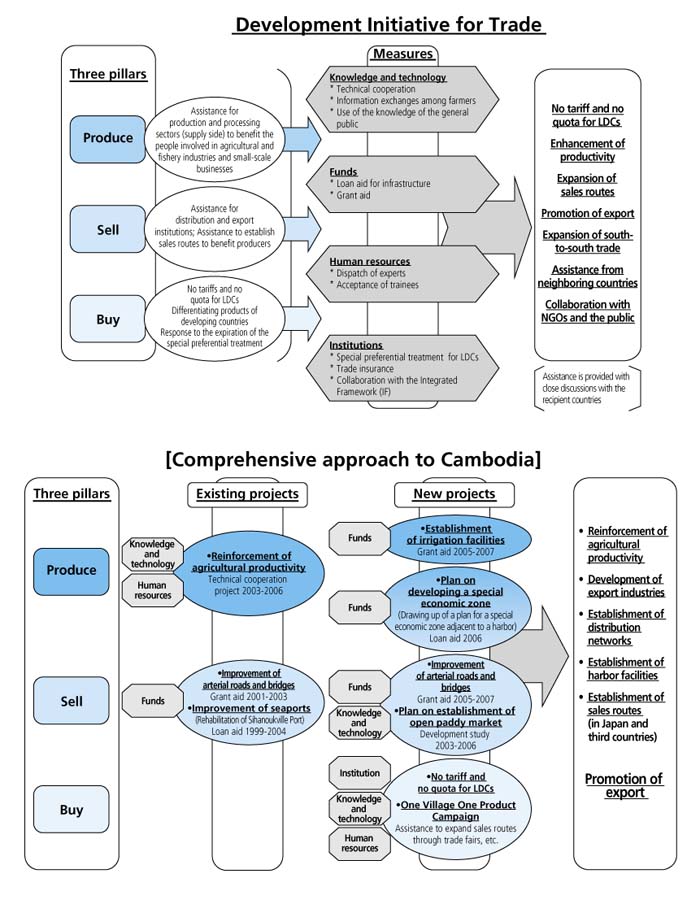Japan's Official Development Assistance White Paper 2006
Box I-1. Outline of the Development Initiative for Trade
Then Prime Minister of Japan, Junichiro Koizumi presented a comprehensive Development Initiative for Trade ahead of the Hong Kong Ministerial Conference of the World Trade Organization (WTO) held in December 2005. This initiative presents comprehensive measures to assist the sustainable development of developing countries through trade. The aim of this Initiative is to support the acquisition of export capacity in developing countries, thereby helping them receive adequate benefits from the free trade system embodied in the WTO.
Japan has long provided generous assistance to developing countries from the perspective of poverty reduction through economic development, contributing to growth in Asia among others. The Initiative was formulated based on the experiences and knowledge Japan had gathered. On various occasions, Japan has asked other developed and higher-middle income countries to follow the Initiative in their own way.
In order for developing countries to gain profits from the free trade system, three factors are critical, in addition to a mere liberalization of trade. These are: (1) the enhancement of capacity to make products with a competitive edge (production) (2) the establishment of distribution routes at home and abroad (distribution) (3) and the development of a market (sales).
The Development Initiative for Trade is aimed at providing comprehensive assistance in each of these three stages of trade, by combining various means such as knowledge and technology, funds, human resources, and institutions, and joining together producers and laborers of developing countries and consumers of both developed and developing countries.
Especially, under the Initiative, goods originated from least developed countries (LDCs) are given no tariffs and no quotas (the measure to exempt tariffs for products from LDCs without limits on import volumes). The Initiative also specifies, a comprehensive approach that combines assistance from Japan with other official frameworks, international organizations, NGOs and the private sector.
In Japan's past engagement, such as in Cambodia for example, a rise in agricultural productivity was sought in the production stage, while in the sales and distribution stages, Japan cooperated mainly in improving roads, bridges, and harbor facilities. Now, however, Japan is giving support to encourage export industries. The support includes building a special economic zone in an area next to a harbor. At the stage of purchase, Japan is preparing to promote the measure of no tariffs and no quotas for LDCs. Japan is also assisting in securing sales routes for products of developing countries by promoting trade fairs and other means.
Also in the Development Initiative for Trade there are especially important measures which include the One Village One Product Campaign, an original Japanese measure to promote local economies, which has proven successful in Thailand and elsewhere. This movement is also being actively introduced in Africa and Central Asia (for more details, see page 13). Other measures seen as important under the said Initiative also include measures to reinforce agricultural productivity and promote villages through the dissemination of the New Rice for Africa (NERICA) (for details, see page 36), such as the African Village Initiative (for details, see page 151).
These measures are considered important under the Development Initiative for trade, since they take into account the needs of the people of the developing countries and contribute to an increase in productivity in the medium and long term.
As of July 2006 the WTO's latest round of negotiations has been suspended. Regardless of the progress of the negotiations, Japan intends to firmly implement the Development Initiative for Trade.


 Next Page
Next Page